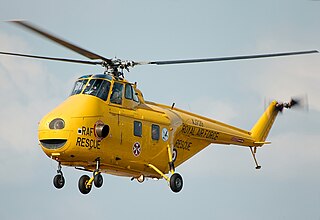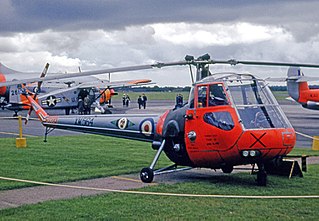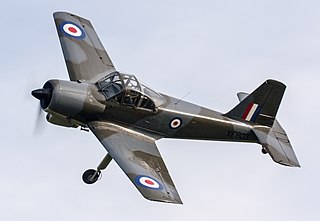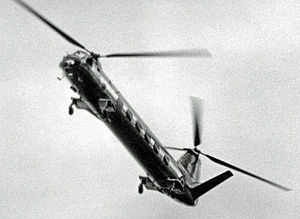A vertical take-off and landing (VTOL) aircraft is one that can hover, take off and land vertically without relying on a runway. This classification can include a variety of types of aircraft including helicopters as well as thrust-vectoring fixed-wing aircraft and other hybrid aircraft with powered rotors such as cyclogyros/cyclocopters and gyrodynes.

The Bristol Aeroplane Company, originally the British and Colonial Aeroplane Company, was both one of the first and one of the most important British aviation companies, designing and manufacturing both airframes and aircraft engines. Notable aircraft produced by the company include the 'Boxkite', the Bristol Fighter, the Bulldog, the Blenheim, the Beaufighter, and the Britannia, and much of the preliminary work which led to Concorde was carried out by the company. In 1956 its major operations were split into Bristol Aircraft and Bristol Aero Engines. In 1959, Bristol Aircraft merged with several major British aircraft companies to form the British Aircraft Corporation (BAC) and Bristol Aero Engines merged with Armstrong Siddeley to form Bristol Siddeley.

The Aérospatiale Gazelle is a French five-seat helicopter, commonly used for light transport, scouting and light attack duties. It is powered by a single Turbomeca Astazou turbine engine and was the first helicopter to feature a fenestron tail instead of a conventional tail rotor. It was designed by Sud Aviation, later Aérospatiale, and manufactured in France and the United Kingdom through a joint production agreement with Westland Aircraft. Further manufacturing under license was performed by SOKO in Yugoslavia and the Arab British Helicopter Company (ABHCO) in Egypt.

The Westland Whirlwind helicopter was a British licence-built version of the U.S. Sikorsky S-55/H-19 Chickasaw. It primarily served with the Royal Navy's Fleet Air Arm in anti-submarine and search and rescue roles.

The AgustaWestland AW101 is a medium-lift helicopter in military and civil use. First flown in 1987, it was developed by a joint venture between Westland Helicopters in the United Kingdom and Agusta in Italy in response to national requirements for a modern naval utility helicopter. Several operators, including the armed forces of Britain, Denmark, and Portugal, use the name Merlin for their AW101 aircraft. It is manufactured at factories in Yeovil, England and Vergiate, Italy; licensed assembly work has also taken place in Japan and the United States.

The Westland Lynx is a British multi-purpose twin-engined military helicopter designed and built by Westland Helicopters at its factory in Yeovil. Originally intended as a utility craft for both civil and naval usage, military interest led to the development of both battlefield and naval variants. The Lynx went into operational usage in 1977 and was later adopted by the armed forces of over a dozen nations, primarily serving in the battlefield utility, anti-armour, search and rescue and anti-submarine warfare roles.

The Bristol Bulldog is a British Royal Air Force single-seat biplane fighter designed during the 1920s by the Bristol Aeroplane Company. More than 400 Bulldogs were produced for the RAF and overseas customers, and it was one of the most famous aircraft used by the RAF during the inter-war period.

The Bristol Type 171 Sycamore was an early helicopter developed and built by the helicopter division of the Bristol Aeroplane Company. The name refers to the seeds of the sycamore tree, Acer pseudoplatanus, which fall with a rotating motion. It has the distinction of being the first British helicopter to receive a certificate of airworthiness, as well as being the first British-designed helicopter to be introduced by and to serve with the Royal Air Force (RAF).

The Sikorsky S-76 is an American medium-size commercial utility helicopter, manufactured by the Sikorsky Aircraft Corporation. The S-76 features twin turboshaft engines, four-bladed main and tail rotors, and retractable landing gear.

The Westland Widgeon was a helicopter developed by Westland Aircraft as a private venture improvement on the Westland WS-51 Dragonfly.

The Westland Scout is a light helicopter developed by Westland Helicopters. Developed from the Saro P.531, it served as a land-based general purpose military helicopter, sharing a common ancestor and numerous components with the naval-orientated Westland Wasp helicopter. The type's primary operator was the Army Air Corps of the British Army, which operated it in several conflict zones including Northern Ireland and the Falklands War.

The Bristol Type 192 Belvedere is a British twin-engine, tandem rotor military helicopter built by the Bristol Aeroplane Company. It was designed by Raoul Hafner for a variety of transport roles including troop transport, supply dropping and casualty evacuation. It was operated by the Royal Air Force (RAF) from 1961 to 1969. The Belvedere was Britain's only tandem rotor helicopter to enter production, and one of the few not built by Piasecki or Boeing.

The Westland WS-51 Dragonfly helicopter was built by Westland Aircraft and was an Anglicised licence-built version of the American Sikorsky S-51.

The Saunders-Roe Skeeter was a two-seat training and scout helicopter that was developed and produced by British manufacturer Saunders-Roe ("Saro") of Cowes and Southampton, in the United Kingdom.

The Gloster Gauntlet was a single-seat biplane fighter designed and produced by the British aeroplane manufacturer Gloster Aircraft in the 1930s. It was the last fighter to be operated by the Royal Air Force (RAF) to have an open cockpit, and also the penultimate biplane fighter in its service.

The Percival P.56 Provost is a basic trainer aircraft that was designed and manufactured by British aviation company Percival.

The Alvis Leonides was a British air-cooled nine-cylinder radial aero engine first developed by Alvis Car and Engineering Company in 1936.

The Alvis Leonides Major was a British air-cooled 14-cylinder radial aero engine developed by Alvis from the earlier nine-cylinder Leonides.

The Westland Westminster was a British helicopter of the 1950s from Westland Aircraft. A large cargo design, it was powered by two turboshaft engines driving a single, five-bladed rotor. Initially unclad, the all-metal airframe was later enclosed in a fabric covering. Designed and built as a private venture without government assistance, it was cancelled when Westland took over rival helicopter producers and their more advanced projects.

The Fairey FB-1 Gyrodyne is an experimental British rotorcraft that used single lifting rotor and a tractor propeller mounted on the tip of the starboard stub wing to provide both propulsion and anti-torque reaction.




















